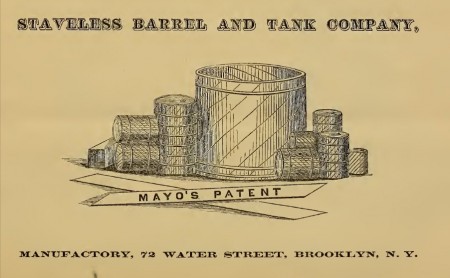History of the 42-Gallon Oil Barrel
19th century coopers made wooden barrels of all capacities, including hogsheads, puncheons, tierces, butts, and tuns.
Soon after America’s first commercial oil well of 1859, a small group met in northwestern Pennsylvania and decided a 42-gallon barrel was best for transporting their oil.
When filled with oil instead of fish or other commodities, a 42-gallon “tierce” weighed 300 pounds. The 42-gallon oil barrel was officially adopted in 1866. Today, a barrel’s refined products include about 20 gallons of gasoline, 12 gallons of diesel and four gallons of jet fuel (and rocket fuel) and other products like liquefied petroleum gases and asphalt.

By the 1860s, barges floated barrels of oil down the Allegheny River to Pittsburgh to be refined into a highly demanded product – kerosene for lamps. Image from an early oil company stock certificate.
In August 1866 a handful of America’s earliest independent oil producers met in Titusville, Pennsylvania, and agreed that henceforth, 42 gallons would constitute a barrel of oil. Pennsylvania led the world in oil production as demand soared for kerosene lamp fuel. (more…)

 The U.S. petroleum industry was just a decade old. As oil discoveries spread from northwestern Pennsylvania, efficiently transporting the new resource became critical.
The U.S. petroleum industry was just a decade old. As oil discoveries spread from northwestern Pennsylvania, efficiently transporting the new resource became critical.